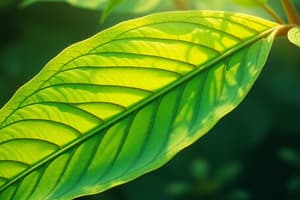Podcast
Questions and Answers
What is the function of the cuticle?
What is the function of the cuticle?
The cuticle is a waxy layer that waterproofs the leaf, preventing excessive water loss.
What is the role of the upper epidermis in a leaf?
What is the role of the upper epidermis in a leaf?
The upper epidermis is a thin, transparent layer that allows light to pass through to the photosynthetic cells.
The upper epidermis contains chloroplasts.
The upper epidermis contains chloroplasts.
False (B)
What is the primary function of the palisade mesophyll?
What is the primary function of the palisade mesophyll?
How does the palisade mesophyll receive carbon dioxide for photosynthesis?
How does the palisade mesophyll receive carbon dioxide for photosynthesis?
Describe the arrangement of cells in the spongy mesophyll.
Describe the arrangement of cells in the spongy mesophyll.
What is the role of the air spaces in the spongy mesophyll?
What is the role of the air spaces in the spongy mesophyll?
What is the vascular bundle composed of?
What is the vascular bundle composed of?
What does the xylem in the vascular bundle transport?
What does the xylem in the vascular bundle transport?
Which of these is transported by the phloem?
Which of these is transported by the phloem?
What is the primary function of the lower epidermis?
What is the primary function of the lower epidermis?
What is the main role of stomata in a leaf?
What is the main role of stomata in a leaf?
Stomata are always open.
Stomata are always open.
What is the function of guard cells?
What is the function of guard cells?
How does water vapor move out of the leaf during transpiration?
How does water vapor move out of the leaf during transpiration?
What happens to carbon dioxide and oxygen during photosynthesis?
What happens to carbon dioxide and oxygen during photosynthesis?
Flashcards
Leaf Cuticle
Leaf Cuticle
A waxy layer that prevents water loss from the leaf.
Upper Epidermis
Upper Epidermis
The outermost layer of the leaf, letting light through.
Palisade Mesophyll
Palisade Mesophyll
Photosynthesis powerhouse; densely packed cells.
Spongy Mesophyll
Spongy Mesophyll
Signup and view all the flashcards
Vascular Bundle (Vein)
Vascular Bundle (Vein)
Signup and view all the flashcards
Xylem
Xylem
Signup and view all the flashcards
Phloem
Phloem
Signup and view all the flashcards
Lower Epidermis
Lower Epidermis
Signup and view all the flashcards
Stomata
Stomata
Signup and view all the flashcards
Guard Cells
Guard Cells
Signup and view all the flashcards
Photosynthesis
Photosynthesis
Signup and view all the flashcards
Transpiration
Transpiration
Signup and view all the flashcards
Gaseous exchange
Gaseous exchange
Signup and view all the flashcards
CO2
CO2
Signup and view all the flashcards
O2
O2
Signup and view all the flashcards
Chloroplasts
Chloroplasts
Signup and view all the flashcards
Diffusion
Diffusion
Signup and view all the flashcards
Translocation
Translocation
Signup and view all the flashcards
Water and Minerals
Water and Minerals
Signup and view all the flashcards
Study Notes
Leaf Structure
-
Cuticle:
- Made of wax, waterproofing the leaf
- Secreted by cells of the upper epidermis
-
Upper epidermis:
- Thin and transparent, allowing light to pass through
- No chloroplasts present
- Acts as a barrier to disease organisms
-
Palisade mesophyll:
-
Main region for photosynthesis
-
- Palisade mesophyll:
- The palisade mesophyll is characterized by a layer of elongated, columnar cells that are closely packed together. This arrangement maximizes the surface area available for light absorption, making it highly efficient for photosynthesis, which is the process through which plants convert light energy into chemical energy in the form of glucose.
- Each of these cells is densely packed with chloroplasts, which contain chlorophyll, the pigment responsible for capturing light energy. This high concentration of chloroplasts allows plants to effectively utilize available sunlight, particularly during daylight hours when photosynthesis is most active.
- The palisade mesophyll cells also have a notable role in gas exchange; they receive carbon dioxide (CO2) through diffusion from the adjoining air spaces located within the spongy mesophyll. This diffusion is crucial for photosynthesis, as CO2 is one of the essential reactants for producing glucose.
- The orientation and arrangement of these cells is adapted to ensure that they absorb optimal light while also facilitating the efficient exchange of gases necessary for plant photosynthesis and respiration.
r cells, packed with chloroplasts to trap light energy
- Palisade mesophyll:
-
Receive CO2 by diffusion from air spaces in the spongy mesophyll
-
-
Spongy mesophyll:
- Cells are more spherical and loosely packed
- Contain chloroplasts, but fewer than palisade cells
- Air spaces allow gaseous exchange (CO2 to cells, O2 from cells) during photosynthesis
-
Vascular bundle:
- A leaf vein, made of xylem and phloem
- Xylem vessels bring water and minerals to the leaf
- Phloem vessels transport sugars and amino acids away (translocation)
-
Lower epidermis:
- Acts as a protective layer
- Contains stomata to regulate water loss (transpiration)
- Site of gaseous exchange into and out of the leaf
-
Stomata:
- Each stoma is surrounded by a pair of guard cells
- Guard cells control whether the stoma is open or closed
- Water vapor passes out during transpiration
- CO2 diffuses in, and O2 diffuses out, during photosynthesis
Studying That Suits You
Use AI to generate personalized quizzes and flashcards to suit your learning preferences.




